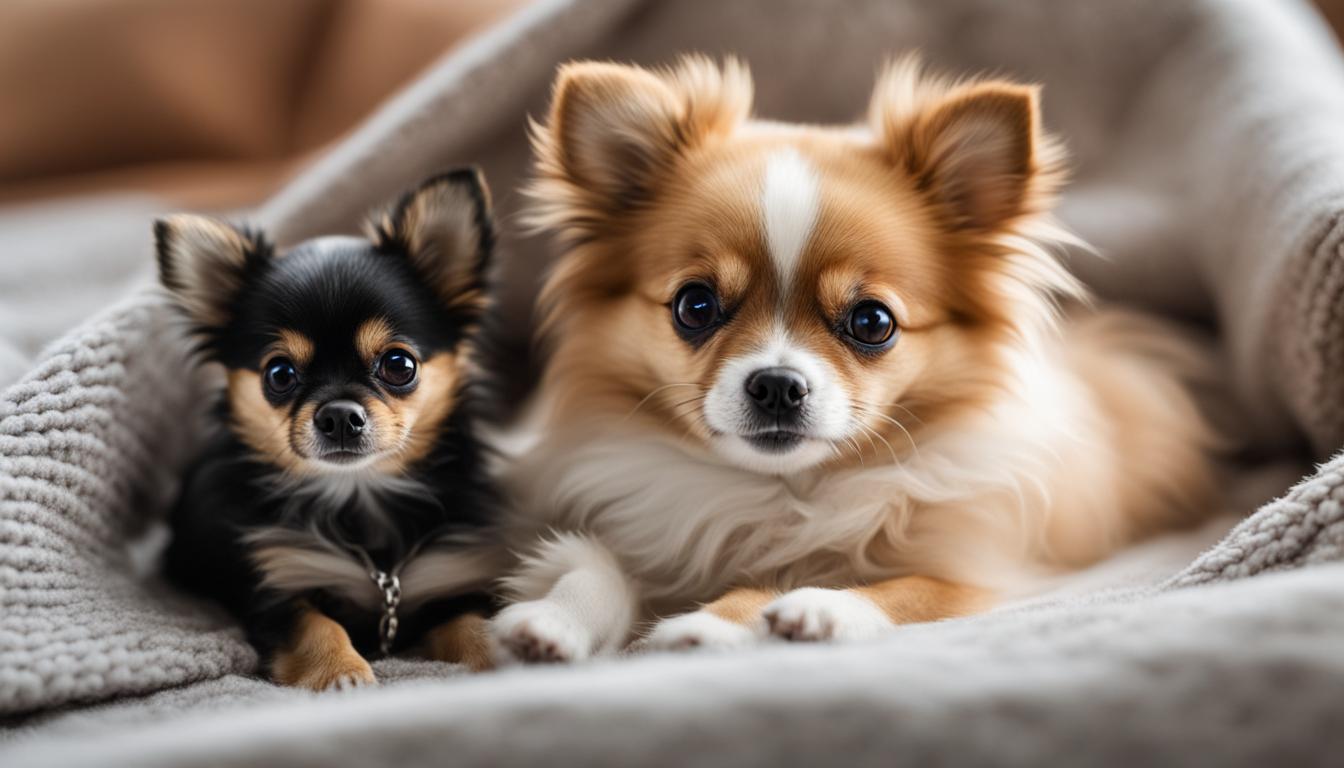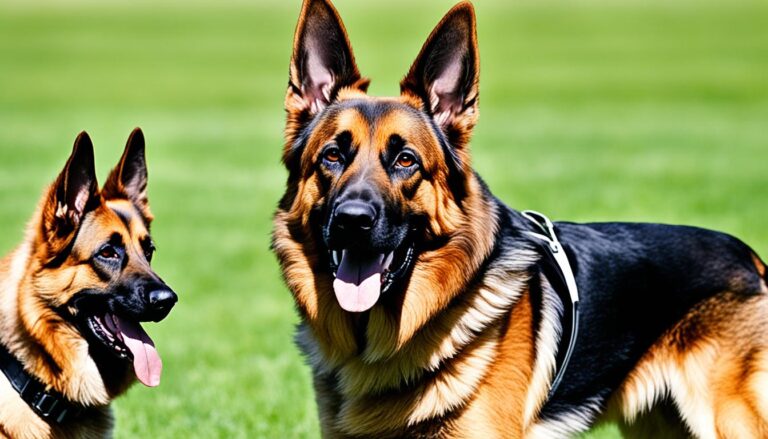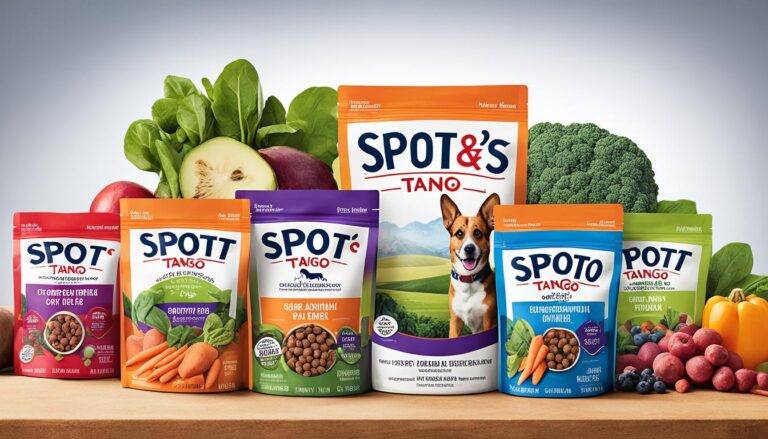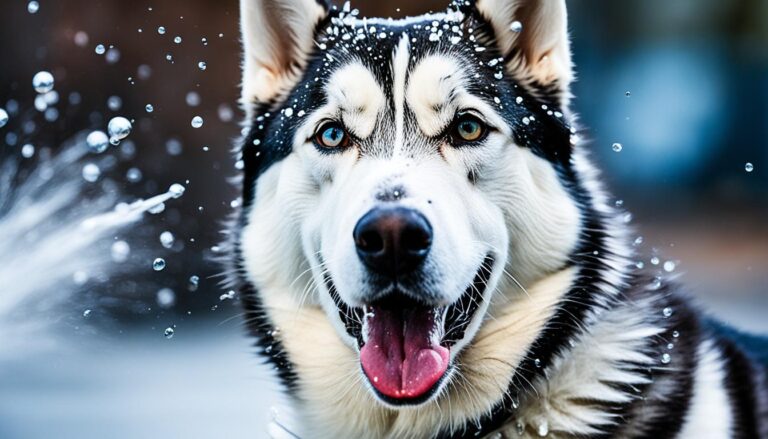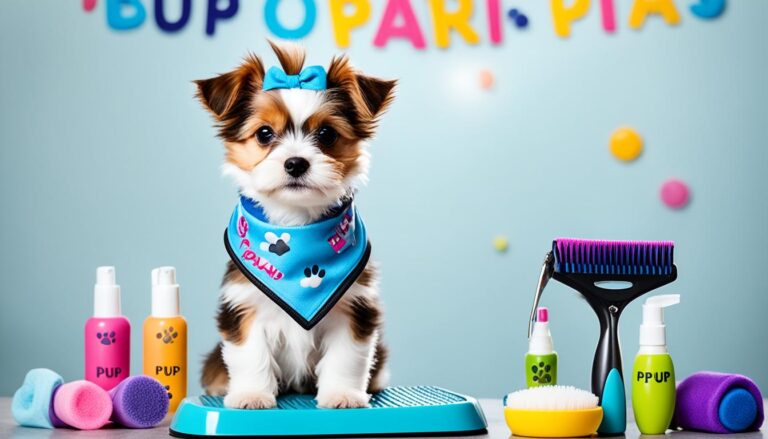Tiny Dogs Description: Breeds & Care Essentials
Description: Small Breeds with Big Personalities
Pixie-like and full of charm, tiny dogs may be pint-sized, but their impact is anything but small. These miniature dog breeds, also known as toy breeds, pack big personalities and endless love into their tiny frames. Don’t let their size fool you—these little dogs are not just accessories, but active and energetic companions that crave play, learn, and exercise.
Whether you’re searching for a compact companion for your apartment or simply fascinated by these little bundles of joy, we’ve got you covered. In this article, we’ll explore the world of tiny dogs, from the various breeds that make up this special group to essential care tips that will ensure their well-being and happiness.
Key Takeaways:
- Toy breeds may be small, but they have big personalities.
- Tiny dogs require the same level of care and attention as larger breeds.
- Small breed dogs make great companions for apartments and urban living.
- Understanding the specific needs of tiny dogs is essential for their health and happiness.
- Proper socialization, training, and exercise are crucial for the well-being of small breed dogs.
Home Safety For Small Dogs
Toy breeds may be active and energetic, but they may need extra help to stay safe in the home. It’s important to provide a safe environment for small dogs to prevent accidents and ensure their well-being.
Preventing Unsupervised Access
Small dogs, such as toy breeds, can easily get themselves into trouble if left unsupervised. To keep them safe, consider using baby gates to restrict their access to certain areas of the house. This way, you can prevent them from exploring potentially hazardous areas, such as the kitchen or stairs.
Assisting with Furniture Access
High furniture, like beds or sofas, might be challenging for small dogs to climb onto or jump off without risking injury. To help them navigate safely, consider using doggie stairs or ramps. These specially designed accessories provide a gentle incline that makes it easier for tiny dogs to reach elevated surfaces without straining their joints or risking falls.
Preventing Injuries
In a home environment, small dogs can accidentally injure themselves in various ways. From small gaps between furniture to sharp corners, there might be hidden hazards lurking around. Inspect your home thoroughly and make necessary adjustments to ensure the safety of your small dog. For example, cover sharp edges with protective padding, secure loose cords and cables, and remove small objects that could be swallowed.
“A safe home is a happy home for small dogs. By taking some simple precautions, we can create a safe environment that allows our furry friends to thrive.”
Public Safety For Small Dogs
Socialization is crucial for toy breed puppies to develop into well-adjusted adult dogs. However, it’s important to be cautious in crowded areas where people may not be attentive to the presence of small dogs. In these situations, picking up your dog or being extra vigilant can help avoid accidents and injuries. It’s essential to prioritize your small dog’s safety in public spaces.
When taking your toy breed dog out in crowded areas, it’s important to be aware of the potential risks and take proactive measures to keep them safe. Here are some tips to ensure public safety for small dogs:
Socialization and Training
Socializing your toy breed dog from a young age is essential in helping them feel more comfortable and confident in different environments. Positive exposure to various sights, sounds, and experiences can help prevent anxiety and fear-related behaviors. Additionally, obedience training plays a crucial role in ensuring your dog’s safety in public spaces by teaching them basic commands and how to respond to potential hazards.
Vigilance and Awareness
In crowded areas, it’s easy for people to overlook the presence of small dogs. Stay vigilant and always keep an eye on your dog to prevent accidents or confrontations with larger dogs. Being aware of your surroundings can also help you anticipate and avoid potential hazards like busy intersections or rough play areas.
Leash and Harness
Always keep your toy breed dog on a leash when in public, regardless of their size. It provides control and prevents them from wandering into dangerous situations or getting lost. Additionally, using a properly fitted harness instead of a collar can distribute pressure more evenly, reducing the risk of neck injuries.
Picking Up when Necessary
In crowded areas with a lot of foot traffic, picking up your small dog can be a proactive safety measure. It helps keep them out of harm’s way and minimizes the risk of accidental injuries caused by the unawareness or carelessness of others. However, ensure that you provide opportunities for your dog to walk and explore as well, as physical activity is essential for their well-being.
By prioritizing your toy breed dog’s safety in public spaces, you can enjoy outings together without unnecessary risks. Remember, small dogs are just as deserving of a safe and enjoyable environment as their larger counterparts.
Greetings For Small Dogs
When it comes to toy breeds, their small size often attracts attention from people of all ages. It’s natural for individuals to be drawn to these adorable pups and want to interact with them. However, it’s crucial to remember that small dogs are living beings and not just stuffed animals. Proper etiquette and awareness are necessary to ensure the well-being and safety of these tiny companions.
**Reminder**: Toy breeds, greetings, picking up, injuries.
Appropriate Greetings
When greeting a small dog, it’s important to approach them with care and respect their personal space. Follow these guidelines for appropriate greetings:
- Approach calmly and avoid sudden movements or loud noises that could startle the dog.
- Allow the dog to approach you if they feel comfortable. Respect their decision if they choose not to interact.
- Extend your hand slowly for the dog to sniff, keeping it at a low and neutral position. Let the dog initiate physical contact.
- Pet the dog gently and avoid rough or aggressive gestures. Pay attention to their body language and stop if they show signs of discomfort.
By following these guidelines, you can ensure a positive and stress-free interaction for both the dog and the person greeting them.
The Dangers of Picking Up
While it may seem harmless, picking up a small dog without permission or careful consideration can lead to fear and potential injuries. Small dogs are delicate creatures, and lifting them improperly can cause physical discomfort or even harm. Additionally, some small dogs may have had negative experiences with being held, which can trigger fear responses.
“Remember that small dogs are not objects to be constantly carried. Treat them with respect and allow them to explore their environment at their own pace.”
If you wish to pick up a small dog, always ask the owner for permission first. They know their dog’s preferences and can guide you on the appropriate way to handle them. When lifting a small dog, support their entire body, ensuring that their spine is aligned and not subjected to unnecessary strain.
| Potential Dangers of Improperly Picking Up Small Dogs | Ways to Ensure Safe Lifting |
|---|---|
|
|
Respecting Small Dogs as Living Beings
We must always remember that small dogs are more than just cute accessories; they are living beings with unique needs and emotions. They require the same love, care, and respect as any other dog. Educating others about appropriate ways to greet and interact with small dogs is crucial in fostering a safe and positive environment for these beloved companions.
Training For Small Dogs
Small dogs, including toy breeds, have the same training needs as larger dogs. They require socialization and obedience training to lead balanced and enriched lives. Don’t underestimate their intelligence and capabilities. Register your toy breed puppy for puppy classes, continue obedience training as they grow, and provide them with opportunities to learn and engage in various activities.
Training small dogs is essential for their well-being and the harmony of your household. Despite their small size, they are intelligent and eager to please. By investing time and effort into their training, you can help them become well-behaved and confident companions.
“Training a small dog is not just about teaching them basic commands. It is about providing them with the tools they need to navigate the world and interact with people and other dogs.”
Socialization is an important aspect of training for small dogs. Expose them to various people, animals, and environments to help them become comfortable and confident in different situations.
Obedience training is also crucial for small dogs. Teach them basic commands like sit, stay, and come, and reinforce these commands regularly. Remember to use positive reinforcement techniques such as treats, praise, and rewards to motivate and encourage your small dog during training sessions.
In addition to basic obedience training, consider engaging your small dog in activities that stimulate their minds and fulfill their energy needs. These activities can include puzzle toys, agility training, interactive play, and scent work. Providing mental stimulation and physical exercise will help prevent boredom and behavioral problems.
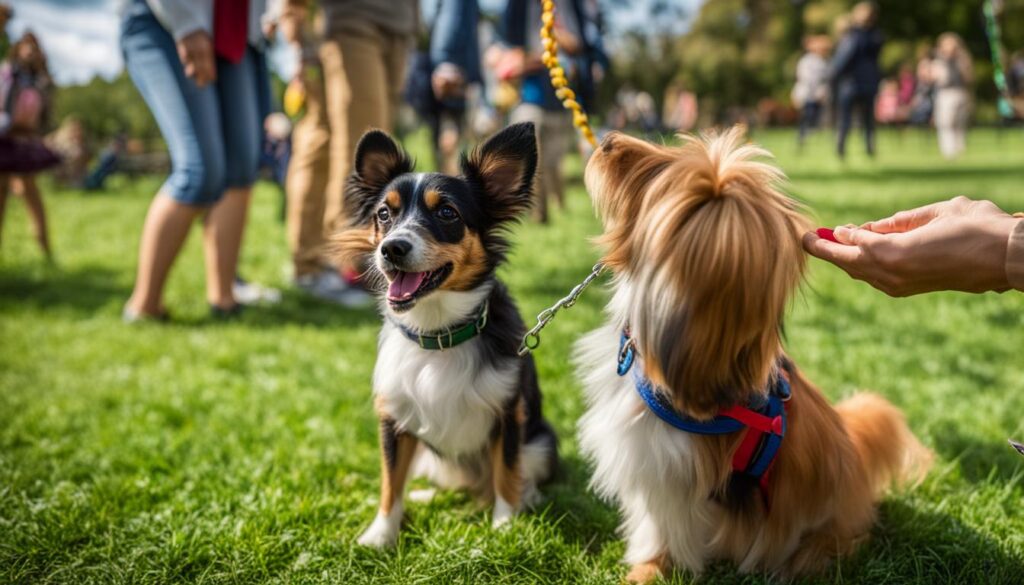
Remember to tailor their training sessions to their size and physical capabilities. For example, avoiding activities that could strain their delicate bones and joints or using smaller-sized training equipment can ensure their safety and well-being.
Consistency, patience, and positive reinforcement are key when training small dogs. Keep training sessions short, frequent, and fun to maintain their focus and interest. Celebrate their successes and be patient with setbacks, understanding that training takes time and effort.
H3: Training Tips:
- Start training early, as soon as you bring your small dog home, to establish good behaviors and prevent the development of bad habits.
- Use positive reinforcement techniques such as treats, praise, and rewards to motivate and encourage your small dog during training sessions.
- Keep training sessions short, frequent, and fun to maintain their focus and interest.
- Be consistent with commands and expectations, using the same words and cues each time.
- Expose your small dog to a variety of people, animals, and environments to help them become well socialized.
- Provide mental stimulation and physical exercise to prevent boredom and behavioral problems.
- Seek professional help if you encounter any difficulties or have specific training goals in mind.
With proper training and socialization, your small dog can become a well-behaved and beloved member of your family. Training not only enhances their behavior but also deepens the bond between you and your furry companion.
Doing It All
Toy breeds are not limited by their size when it comes to accomplishments. These small dogs can excel in various roles and activities, showcasing their intelligence and versatility. Whether it’s serving as service dogs, working as therapy dogs, participating in dog sports, or showcasing their skills in performance events, toy breeds are capable of achieving remarkable feats.
Service dogs play a crucial role in assisting individuals with disabilities, providing support and enhancing their quality of life. Toy breeds have proven themselves to be adept at this important job, offering comfort, companionship, and assistance to those in need.
Therapy dogs bring comfort, joy, and healing to people in hospitals, nursing homes, and other healthcare settings. Toy breeds’ gentle nature, empathy, and size make them perfect candidates for this role, enabling them to provide emotional support to individuals of all ages.
Dog sports offer opportunities for toy breeds to showcase their athleticism, agility, and intelligence. From obedience and agility trials to scent work and trick competitions, these small dogs can impress with their skills and abilities.
The Benefits of Dog Sports for Toy Breeds
Engaging in dog sports provides numerous benefits for toy breeds:
- Physical Exercise: Active participation in dog sports ensures that toy breeds receive the necessary physical exercise to maintain their health and well-being.
- Mental Stimulation: Dog sports challenge toy breeds’ minds, keeping them mentally stimulated and preventing boredom.
- Bonding and Socialization: Participating in dog sports allows toy breeds to bond with their owners and interact with other dogs, promoting socialization skills.
- Confidence Building: Successfully mastering the skills required in dog sports helps boost the confidence of toy breeds, enhancing their overall personality.
It is important not to underestimate the athletic abilities of toy breeds. With proper training, guidance, and opportunities, these small dogs can compete alongside larger breeds and excel in performance events.
Having a toy breed by your side in various areas of life can bring immense joy and pride. These small dogs prove that size is not a limitation and that they are more than capable of achieving great things. Whether it’s serving as loyal service dogs, providing comfort as therapy dogs, or showcasing their skills in dog sports and performance events, toy breeds continue to impress and inspire.
Seeing the World Through a Small Dog’s Eyes
To truly understand tiny dogs, it’s important to shift our perspective and see the world through their eyes. Due to their small size, their environment may appear different and even intimidating. Everyday objects like furniture and the floor can seem much larger and more daunting to them. By considering their perspective, we can create a living environment that is safe, comfortable, and tailored to their needs.
When designing their living space, it’s crucial to provide essential items within easy reach. Placing a water dish at their level ensures they have access to hydration without struggling. Additionally, we should consider the height of furniture, as small dogs may need to jump on it to access their favorite spots or seek comfort. By understanding their unique needs, we can make adjustments to their environment that promote their well-being.
Seeing the world through a small dog’s eyes helps us empathize with their experiences and provides valuable insights into their daily lives. It reminds us to be mindful of their limitations and considerate of their needs. By creating a safe and comfortable environment, we can provide tiny dogs with the love and care they deserve.
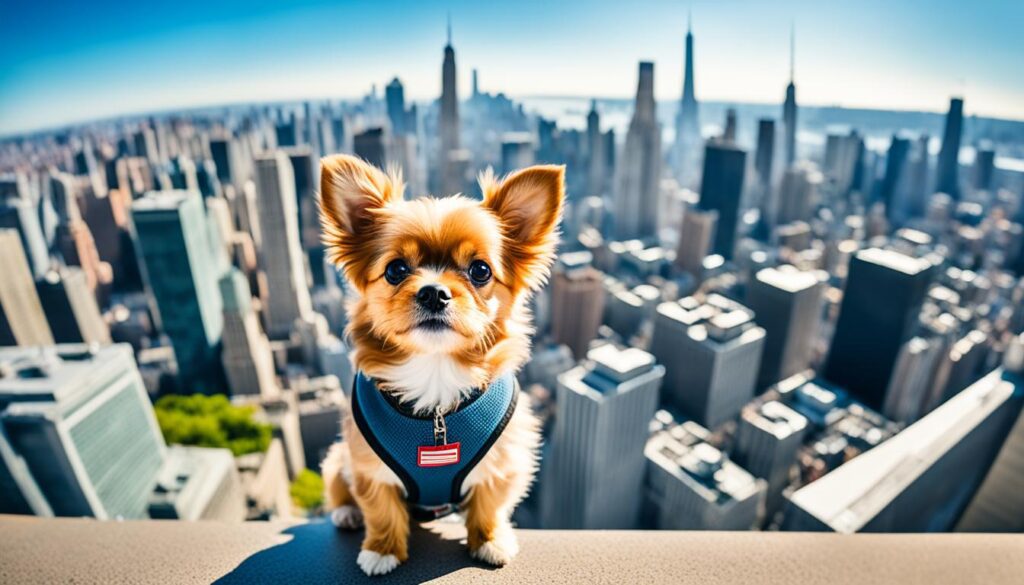
Small Breed Dogs: All Shapes & Sizes
When it comes to small dogs, there is a wide variety of shapes and sizes to choose from. Whether you’re looking for a compact and sturdy companion or a more sensitive and delicate breed, there’s a small dog out there that will fit your lifestyle and preferences.
Some small breed dogs, like the Jack Russell Terrier and French Bulldog, are known for their compact and sturdy build. These dogs may be small in size, but they are robust and full of energy. They make great companions for active individuals or families with an active lifestyle.
On the other hand, there are small dogs that have a more sensitive and delicate nature. These breeds require gentle handling and a calm environment. They may be more suited to individuals or families who prefer a quieter lifestyle and are looking for a dog that matches their temperament.
Certain small dog breeds also have distinct features that make them easily recognizable. Take, for example, the long-backed Dachshund, known for its unique body shape. Or the round-headed Japanese Chin, with its adorable and distinctive appearance. These distinct features add to the charm and appeal of these small dogs.
When choosing a small breed dog, it’s important to consider their specific needs and characteristics. Some breeds may require more exercise and mental stimulation, while others may have specific grooming or training requirements. By understanding the traits and needs of different small breeds, you can make an informed decision and ensure a lifelong bond with your new four-legged companion.
Overall, small breed dogs come in all shapes and sizes, each with their own unique qualities. Whether you’re drawn to the compact and sturdy breeds or prefer the sensitive and delicate ones, there is a small dog out there that will capture your heart and bring joy to your life.
Small Dog Syndrome
Small dogs often exhibit naughty behaviors that can be attributed to a phenomenon known as “small dog syndrome.” This term refers to the tendency of small dogs to get away with behaviors that would be considered unacceptable in larger breeds.
Regardless of their size, it’s essential to recognize and address inappropriate behaviors in small dogs, such as pulling on the leash or snarling. These behaviors should not be overlooked or dismissed simply because the dog is small.
Proper socialization and training from an early age are key in preventing the development of small dog syndrome. By exposing your small dog to various environments, people, and other dogs, you can help them become well-rounded and well-behaved companions.
Training is crucial for small dogs to learn proper behavior and obedience, just like any other breed. Implementing consistent training methods will teach your small dog boundaries and help them understand what is expected of them.
By addressing naughty behaviors and providing appropriate socialization and training, you can prevent small dog syndrome and ensure that your canine companion is a well-behaved and delightful addition to your family.
Understanding Naughty Behaviors in Small Dogs
Small dogs often display naughty behaviors that can be attributed to small dog syndrome. It’s important to address these behaviors through proper socialization and training to ensure a well-behaved companion.
| Common Naughty Behaviors | Preventive Measures |
|---|---|
| Pulling on the leash | Implement leash training techniques and use appropriate walking equipment. |
| Excessive barking | Provide mental and physical stimulation, and use positive reinforcement to redirect their focus. |
| Guarding behavior | Establish clear boundaries and use positive reinforcement to encourage sharing and socializing. |
| Jumping on people | Teach your small dog to greet people calmly and reward them for keeping all four paws on the ground. |
Addressing these naughty behaviors early on and consistently reinforcing desired behavior through positive reinforcement will help your small dog become a well-behaved and happy member of your family.
Food Requirements: Less Means More
Small breeds have different calorie requirements compared to large dogs. Due to their higher surface area per kilogram, they expend energy at a faster rate. However, it’s crucial to prevent them from gaining excess weight, as obesity can be just as dangerous for small dogs as it is for larger ones. Small and frequent meals tailored to their needs can help maintain their optimal weight and health.
When it comes to feeding small breeds, it’s important to consider their size and energy expenditure. While they may have smaller stomachs, their calorie requirements are higher relative to their body weight. Providing them with small and frequent meals throughout the day can help meet their energy needs without overfeeding.
Calorie control plays a significant role in preventing obesity in small breeds. Obesity can lead to various health issues, such as joint problems, diabetes, and heart disease. Therefore, it’s essential to monitor their calorie intake and ensure they’re getting the right balance of nutrients.
Choosing a high-quality dog food specifically formulated for small breeds is important. These formulas are designed to meet their unique nutritional needs, taking into account their size, metabolism, and overall health. Look for dog foods that are labeled as suitable for small breeds or consult with your veterinarian for personalized feeding recommendations.
“Proper nutrition is key to maintaining the ideal weight and overall health of small breed dogs. By feeding them the right amount of high-quality food, we can ensure that they receive the necessary nutrients without the risk of obesity.” – Dr. Sarah Thompson, DVM
In addition to providing a balanced diet, regular exercise is crucial for small breeds. Engaging in daily activities like short walks, play sessions, and mental stimulation can help them burn off excess energy and maintain a healthy weight. It’s important to find the right balance between exercise and rest, as small dogs may tire more easily than larger breeds.
Calorie Requirements for Common Small Breeds
| Breed | Weight Range (lbs) | Calorie Requirements (per day) |
|---|---|---|
| Chihuahua | 2 – 6 | 250 – 400 |
| Pomeranian | 3 – 7 | 350 – 500 |
| Shih Tzu | 9 – 16 | 400 – 650 |
| Maltese | 4 – 7 | 400 – 600 |
These are general guidelines, and the specific calorie requirements may vary depending on factors such as age, activity level, and overall health. Consulting with your veterinarian can help determine the precise calorie needs for your small breed dog.
In conclusion, small breeds require special attention when it comes to their food requirements. Providing them with balanced, calorie-controlled meals and regular exercise can help them maintain a healthy weight and overall well-being.
Special Considerations for Puppies
When it comes to small breed puppies, there are some special considerations that need to be taken into account. Their unique characteristics and needs require tailored care to ensure their healthy development. Here are some important factors to consider:
Frequent Feeding
Due to their small stomach capacity, small breed puppies need smaller portions of food but more frequent feedings throughout the day. This helps prevent digestive issues and ensures they receive adequate nutrition to support their fast metabolism and energy needs.
Calorie-Dense Meals
Small breed puppies have higher energy requirements compared to larger breed puppies. To meet their nutritional needs, it is important to provide them with calorie-dense meals specifically formulated for small breeds. These meals should be packed with essential nutrients and carefully balanced to support their growth and development.
Early Training
Training should begin early in a small breed puppy’s life. Establishing good behaviors and building a strong foundation of obedience is crucial for their future well-being. Start with basic commands and positive reinforcement techniques to shape their behavior and create a reliable and well-behaved adult dog.
Consultation with Experts
When it comes to the dietary needs and training requirements of small breed puppies, it is always beneficial to consult with experts. Your veterinarian can provide valuable guidance on suitable feeding guidelines and recommend high-quality puppy food brands. They can also offer advice on effective training methods and address any concerns you may have.
Providing the right care and attention to small breed puppies sets the stage for a healthy and happy future. By understanding their specific needs and taking appropriate measures, you can ensure that your small breed puppy grows into a well-rounded and delightful companion.
Conclusion
In conclusion, small dogs come in a wide variety of breeds, each with their own unique personalities and care requirements. Despite their compact size, these dogs are not simply accessories, but beloved companions who deserve the same love, care, and training as any other dog.
Providing a safe environment is crucial for small dogs, as they may be more prone to accidents or injuries. Socialization is also key to helping them develop into well-adjusted and confident dogs. Meeting their exercise and training needs is essential for their overall well-being and happiness.
It’s important to note that small dogs can live long and healthy lives, but they also have specific health considerations that should be taken into account. Regular veterinary check-ups, a balanced diet, and preventive care are important for maintaining their health and longevity.
Owning a small dog can be a truly rewarding experience, filled with love and companionship. Whether you choose a tiny toy breed or a compact small breed, with proper care and attention, these pint-sized pups can bring immense joy to your life.
FAQ
What breeds are considered tiny dogs?
Tiny dogs, also known as small breed dogs or miniature dog breeds, include breeds like Chihuahua, Pomeranian, Yorkshire Terrier, Toy Poodle, Maltese, and Shih Tzu, among others.
Are tiny dogs suitable for apartments?
Yes, many tiny dog breeds are well-suited for apartments due to their small size and lower exercise needs. However, it’s important to ensure they still get enough mental stimulation and physical exercise to keep them happy and healthy.
How can I make my home safe for a small dog?
To make your home safe for a small dog, you can use baby gates and doggie stairs/ramps to prevent access to stairs and help them get on and off high furniture safely. It’s important to provide a safe environment to prevent accidents and injuries.
How should I socialize my toy breed puppy?
Socialization is crucial for toy breed puppies. However, in crowded areas, it’s important to be cautious and pick up your dog or be extra vigilant to avoid accidents and injuries. Prioritizing your small dog’s safety in public spaces is essential.
How should I handle greetings with strangers for my small dog?
While it’s natural for people to want to pet small dogs, it’s important to remind them to approach appropriately. Picking up your dog or being cautious about strangers picking them up can help avoid fear and potential injuries.
Does my small dog need training?
Yes, small dogs, including toy breeds, have the same training needs as larger dogs. They require socialization and obedience training to lead balanced and enriched lives. Don’t underestimate their intelligence and capabilities.
Can toy breeds excel in specific activities?
Yes, toy breeds can excel in various roles and activities. They can be service dogs, therapy dogs, and participate in dog sports like obedience, agility, scent work, and tricks. Don’t underestimate their athletic abilities.
How can I create a safe living environment for my small dog?
Understanding things from your small dog’s perspective can help. Providing essentials within easy reach and considering the height of furniture they may need to jump on are important. Ensuring a safe and comfortable living environment is essential.
What should I consider when choosing a small breed dog?
When choosing a small breed dog, consider their specific needs and characteristics. Some breeds are more compact and sturdy, while others are more sensitive and delicate. It’s important to choose a breed that fits your lifestyle and preferences.
Do small dogs have different behavior expectations than larger breeds?
Small dogs often get away with inappropriate behaviors, known as “small dog syndrome,” but it’s important to correct these behaviors regardless of the dog’s size. Proper socialization and training from an early age are crucial for a well-behaved canine companion.
Do small dogs have different dietary needs?
Yes, small breeds have different calorie requirements compared to large dogs. They expend energy at a faster rate due to their higher surface area per kilogram. However, it’s crucial to prevent them from gaining excess weight. Small and frequent meals tailored to their needs can help maintain their optimal weight and health.
Are there special considerations for small breed puppies?
Yes, small breed puppies have special considerations. They require more frequent calorie-dense meals to support their fast metabolism and energy needs. Early training is essential to establish good behaviors. Consult food labels and your veterinarian for feeding guidelines suitable for small breed puppies.

